- Quick Links
- Articles
- Decon Services
- Products
- In-Person Workshops
- Webinars
Applications
ClorDiSys Solutions’ gaseous CD is the safest and most effective way to decontaminate your BSL-3 and BSL-4 laboratories, passthroughs, chambers, biological safety cabinets, HEPA filters and any other lab spaces. Chlorine dioxide gas is gentle on materials so animal racks, cages, computers and other sensitive equipment can be left in these areas during the decontamination process. In new or renovated facilities, all your brand new equipment can be brought in, gassed and sterilized in place thus eliminating the need for time consuming and costly autoclaving during move-in. In your existing laboratories, rooms and equipment can be decontaminated all together in one single step.
Our chlorine dioxide gas is registered with US Environmental Protection Agency as a sterilant and is able to inactivate all forms of antimicrobial life, including spores. Our process has also proven effective at Inactivating Pinworms Eggs and Inactivating Amplicons.


The CD Gas Advantage
- ClorDiSys' CD Gas is an EPA registered sterilant, making it effective against all viruses, bacteria, fungi and spores
- Non-carcinogenic, residue free process
- True gases are the only agents effective in hard to reach areas such as HVAC systems, cracks and crevices, and inside equipment.
- Gaseous CD is the only decontaminating fumigant that penetrates water, decontaminating both the water and the surface beneath.
- Safe on materials such stainless steel, anodized aluminum, painted steel, plastics, epoxy flooring and paints, gasket materials, and electronics
Common Industry Applications
Chlorine dioxide gas fills the space it's contained within completely and evenly, ensuring that no matter how large the target space is,
or how much equipment is within the space, no surface is left untouched. Traditional room decontamination times are approximately 2.5-3.5 hours depending
on their size and the accompanying air handling unit.
Examples of room types decontaminated with chlorine dioxide gas are:
Animal Holding Rooms
BSL-3 and BSL-4 labs
Cold Rooms
Cage Wash Rooms
Procedure Rooms
Quarantine Rooms
Micro Labs
Necropsy Rooms
Airlocks and Passthrough Rooms
Available Products: ClorDiSys Decontamination Services | Minidox-M | Minidox-B
 |
 |
Chlorine dioxide gas fills the space it's contained within completely and evenly, ensuring that no matter how large the target space is,
no surface is left untouched; including crevices and harbor locations. CD Gas has successfully treated many vivarium facilities to eliminate pathogens and pinworms,
new facilities to establish sterility, as well as facilities undergoing renovation.
A 240,000 ft3 new vivarium was decontaminated following construction and commissioning, but just prior to the move-in date. Equipment and supplies were
brought into the facility prior to the decontamination, so they would not need to be autoclaved into the barrier facility. This saved a significant
amount of time at the facility, while allowing for the safe decontamination of electronics into the facility.
ClorDiSys has also decontaminated multiple mouse breeding facilities, eliminating pinworms, molds, and other contaminants. Depending on the size, facility
decontamination can take place using our equipment or through our decontamination services.
Available Products: ClorDiSys Decontamination Services | Minidox-M
 |
 |
For applications where the entire room does not need to be decontaminated, equipment can be tented and fumigated in place. This allows for a smaller
volume to be treated, lowering treatment times and costs compared to decontaminating the entire room. With a proper seal, production and other work can take place
in the same room as the tented equipment undergoing decontamination.
Available Products: ClorDiSys Decontamination Services | Minidox-M | Minidox-B
 |
 |
Bringing equipment, tools and supplies into a barrer facility is a potential pathway for pathogens to enter your clean room. We have a few products which
can help eliminate pathogens in order to preserve the sterility of your barrier. Our CD Gas equipment can be used within a Decontamination Chamber or
combination Rack Washer/Decontamination Chamber to provide a six-log sporicidal reduction of all items being processed. We can also help design a Passthrough Room that can achieve
the same results without needing to purchase a chamber (see photos below). Items can include animal racks, electronics, HEPA filters, and many other items that cannot be autoclaved
into the facility. Passthrough rooms can also be designed and built into a facility, without the need to purchase a specialized chamber.
We also offer UV passthrough chambers and UV passthrough tunnels to disinfect bedding and feed bags as well as small electronics, tools, and other items entering a barrier facility.
Available Products: Decontamination Chamber | Passthrough Isolators | Flash-Thru Chamber | Flash Tunnel
 |
 |
 |
 |
For situations when the whole room does not need to be decontaminated, we offer a number of options for surface treatments. Liquid chlorine dioxide can be
used to fog, spray, or wipe surfaces down in order to disinfect or sterilize that location. Ultraviolet light can be used to disinfect the visible surfaces within a room,
whether they are benchtops and casework, or the common touch points on equipment.
Available Products: the Torch UV Disinfection | Lantern UV Disinfection | CSI-3000 | CD-Tabs
 |
 |
Chlorine dioxide gas decontamination of isolators is quick, residue free, and cycle development free. Isolators can be decontaminated
in under an hour whether they are empty or full of components. We also build custom isolators, as seen in the photo on the right. These can be nearly any size,
and have numerous options available.
One customer has been decontaminating their processing isolator (seen on left) with chlorine dioxide gas 2-3 times daily, totaling over 1000 decontaminations.
Available Products: Minidox-M | Minidox-B | Minidox-L | Passthrough Isolators
 |
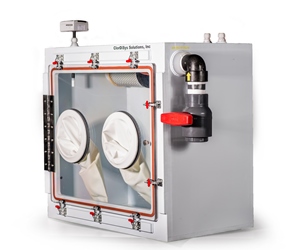 |
Traditional sanitation procedures typically do not include Air Handling Units or their accompanying ductwork. When decontaminating with CD gas,
it is often times very easy to include the ductwork and air handling system (even HEPA housings) in the scope of the project. CD gas penetrates through HEPA filters
as if they are not there, and being a dry gas it is able to navigate the bends and turns of the ductwork system without condensing and getting "stuck."
Available Products: ClorDiSys Decontamination Services | Megadox-P | Minidox-M
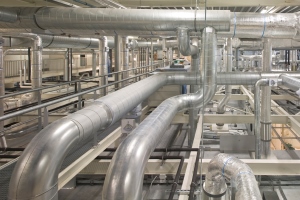 |
 |
Chlorine dioxide gas was shown to be effective at inactivating pinworm eggs through a study performed at the University of Tennessee at Knoxville,
which you can read here. We have since worked with numerous facilities around the world,
including commercial breeding facilities, to eliminate pinworm eggs from their environments. Pinworm eggs are extremely small and light, allowing them to be carried through the air and
be spread easily throughout a facility. Chlorine dioxide gas is able to completely fill the environment it is introduced into, and penetrates crevices extremely well in order to
contact and inactivate the eggs wherever they are. This includes the hard-to-reach areas such as animal racks, their cages, their air plenums, HVAC grills, behind and underneath equipment, etc.
This allows for the complete inactivation of pinworm eggs from an environment, such that the problem doesn't come right back when animals are reintroduced to the room.
An animal facility in Australia had a widespread pinworm contamination. The facility was first decontaminated with hydrogen peroxide vapor, but the animals became infected with pinworms
after just 3 weeks. As pinworm diagnosis can take 8-23 days after infectivity, this shows that the animals most likely were reinfected by leftover pinworm eggs that hydrogen peroxide
did not inactivate. Chlorine dioxide gas was then used to decontaminate the facility, and have gone multiple years without pinworm issues.
Available Products: ClorDiSys Decontamination Services | Minidox-M
 |
 |
Biological Safety Cabinets are able to be decontaminated with chlorine dioxide gas quickly and effectively. We work with a number of Certification
companies around the world who certify and decontaminate Biological Safety Cabinets. To find the company nearest to you, please click here.
Chlorine dioxide gas has been used by multiple facilities to decontaminate vehicles and shipping containers. Commercial breeders have decontaminated their delivery vehicles to ensure
that there are no pathogens present which can infect the animals. Shipping containers have been used as a decontamination chamber, where items can be placed inside and decontaminated
outside the area.
Our Cloridox-GMP can be used to connect up to autoclaves and run vacuum pressure chlorine dioxide gas decontaminations within the chamber.
Available Products: ClorDiSys Decontamination Services | Cloridox-GMP | Minidox-M
 |
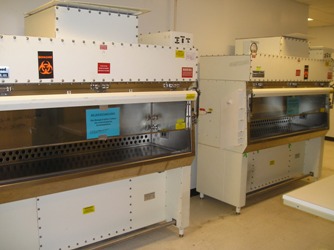 |
 |
 |
